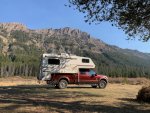.fisher
New member
Looking to pick the brains of the collective here, after more Googling than I care to admit.
I have a 1999 Bigfoot 2500 that I'm prepping for the upcoming ski season. Since some of us don't have a heated garage that'll fit one of these rigs what are some tips for SHORT TERM storage during below freezing temps?
what are some tips for SHORT TERM storage during below freezing temps?
After a week of skiing or winter camping I'll inevitably have to head back to the real world and park the rig in my driveway. Once there, I'm mainly uncertain how to best keep pipes from freezing etc. What can I do to avoid going through the winterization process each time? I may want to get on the road and chase a storm at any time and am trying to figure out the best way to keep the rig prepped to be mobilized.
My plan thus far is to wrap the freshwater pipes with heating cables and insulation, and add a couple heating pads to the fresh / holding tanks. These devices looks to be fairly low draw and have thermostats built in. When I get home I can plug into shore power to keep temps maintained and can unplug and go. Antifreeze in the holding tanks via any drains will of course be needed, too.
I'm sure there's some other ideas out there better than mine. Anything I've missed?
Truck camper pic to entice ya'll

Cheers
Andy
I have a 1999 Bigfoot 2500 that I'm prepping for the upcoming ski season. Since some of us don't have a heated garage that'll fit one of these rigs
After a week of skiing or winter camping I'll inevitably have to head back to the real world and park the rig in my driveway. Once there, I'm mainly uncertain how to best keep pipes from freezing etc. What can I do to avoid going through the winterization process each time? I may want to get on the road and chase a storm at any time and am trying to figure out the best way to keep the rig prepped to be mobilized.
My plan thus far is to wrap the freshwater pipes with heating cables and insulation, and add a couple heating pads to the fresh / holding tanks. These devices looks to be fairly low draw and have thermostats built in. When I get home I can plug into shore power to keep temps maintained and can unplug and go. Antifreeze in the holding tanks via any drains will of course be needed, too.
I'm sure there's some other ideas out there better than mine. Anything I've missed?
Truck camper pic to entice ya'll

Cheers
Andy
Last edited:
